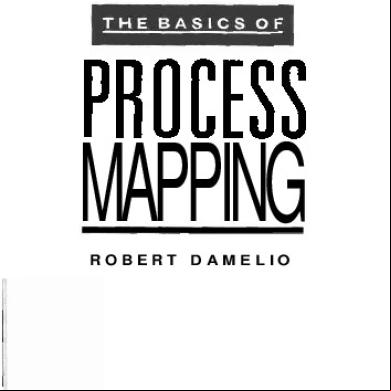Time Based Process Mapping 3z5263
This document was ed by and they confirmed that they have the permission to share it. If you are author or own the copyright of this book, please report to us by using this report form. Report 3b7i
Overview 3e4r5l
& View Time Based Process Mapping as PDF for free.
More details w3441
- Words: 442
- Pages: 2
Time Based Process Mapping
Purpose: This tool is used when you’re looking to improve efficiency and effectiveness throughout a business cycle or process Directions: 1. Investigate the process you have chosen to map. Sketches low diagram of this process to show the linkages and dependencies of subprocesses within it 2. Next get data on the time that it takes is taking real jobs to through each of the subprocesses and the time spent waiting between them. 3. Using the information from above, calculate the total time that the overall process consumes from beginning to end. It is worth comparing the theoretical time to the actual times that the jobs are taking. This ensures that you have not overlooked any stages of the process. 4. Plot the time based processing map. The top axis will show the total time from start to finish of the process. The left-hand axis will show the various subprocesses within the overall process. For simplicity, they should be listed in the order that they are are to be performed. 5. Draw in process past represent the typical start and finish time of each. The process. Ideally use average times. However, in some instances, it may be important to show the maximum and minimum times. 6. Highlight the value adding subprocesses. These can be identified by asking the following questions: - Does it all to the nature of the product or service in any way that the consumer the customer would want - If yes, then it is adding value. If no, then it’s a non-value adding (e.g. rework, waiting, storage, queuing) 7. Label on the team BPM the value adding time and breakdown the non-value adding time into it areas 8. Calculate the value adding time as a percentage of the total time. This will be used as a state of the ground for the measurement of future improvements 9. Consider all the elements of non-value adding time and create an action plan to minimise if not eliminate the non-value adding time. © Exponential Training & Assessment Ltd 2013
http://www.exponentialtraining.com
Time Based Process Mapping
Key points Not all non-value adding is date is bad (i.e. some transportation may be needed to get the product to the customer) what TV be PM does is highlight the areas of opportunity for improvement. It is important to question why it is necessary and how non-value adding can be minimised.
Timescale Processes Wait to check in delivery Unloading deliveries
1 hour
2 hour
3 hour
Wait to transfer to storage bins Product into storage bins Update been records Transfer been records to database
© Exponential Training & Assessment Ltd 2013
http://www.exponentialtraining.com
Purpose: This tool is used when you’re looking to improve efficiency and effectiveness throughout a business cycle or process Directions: 1. Investigate the process you have chosen to map. Sketches low diagram of this process to show the linkages and dependencies of subprocesses within it 2. Next get data on the time that it takes is taking real jobs to through each of the subprocesses and the time spent waiting between them. 3. Using the information from above, calculate the total time that the overall process consumes from beginning to end. It is worth comparing the theoretical time to the actual times that the jobs are taking. This ensures that you have not overlooked any stages of the process. 4. Plot the time based processing map. The top axis will show the total time from start to finish of the process. The left-hand axis will show the various subprocesses within the overall process. For simplicity, they should be listed in the order that they are are to be performed. 5. Draw in process past represent the typical start and finish time of each. The process. Ideally use average times. However, in some instances, it may be important to show the maximum and minimum times. 6. Highlight the value adding subprocesses. These can be identified by asking the following questions: - Does it all to the nature of the product or service in any way that the consumer the customer would want - If yes, then it is adding value. If no, then it’s a non-value adding (e.g. rework, waiting, storage, queuing) 7. Label on the team BPM the value adding time and breakdown the non-value adding time into it areas 8. Calculate the value adding time as a percentage of the total time. This will be used as a state of the ground for the measurement of future improvements 9. Consider all the elements of non-value adding time and create an action plan to minimise if not eliminate the non-value adding time. © Exponential Training & Assessment Ltd 2013
http://www.exponentialtraining.com
Time Based Process Mapping
Key points Not all non-value adding is date is bad (i.e. some transportation may be needed to get the product to the customer) what TV be PM does is highlight the areas of opportunity for improvement. It is important to question why it is necessary and how non-value adding can be minimised.
Timescale Processes Wait to check in delivery Unloading deliveries
1 hour
2 hour
3 hour
Wait to transfer to storage bins Product into storage bins Update been records Transfer been records to database
© Exponential Training & Assessment Ltd 2013
http://www.exponentialtraining.com





